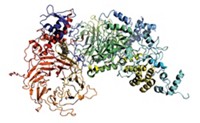Advertisement
Grab your lab coat. Let's get started
Welcome!
Welcome!
Create an account below to get 6 C&EN articles per month, receive newsletters and more - all free.
It seems this is your first time logging in online. Please enter the following information to continue.
As an ACS member you automatically get access to this site. All we need is few more details to create your reading experience.
Not you? Sign in with a different account.
Not you? Sign in with a different account.
ERROR 1
ERROR 1
ERROR 2
ERROR 2
ERROR 2
ERROR 2
ERROR 2
Password and Confirm password must match.
If you have an ACS member number, please enter it here so we can link this account to your membership. (optional)
ERROR 2
ACS values your privacy. By submitting your information, you are gaining access to C&EN and subscribing to our weekly newsletter. We use the information you provide to make your reading experience better, and we will never sell your data to third party members.
Biological Chemistry
Peering Deeper Into The Prenylome
Researchers report a method for tagging prenylated proteins to observe their activity and that of prenyltransferase inhibitors in vivo
by Sarah Everts
February 23, 2009
| A version of this story appeared in
Volume 87, Issue 8
An international research team has set out to develop new tools for analyzing the so-called prenylome, a set of natural proteins modified by lipid (prenyl) chains that are involved in a host of mammalian cell processes (Nat. Chem. Biol., DOI: 10.1038/nchembio.149). Bioinformatics studies predict that 2% of human proteins are prenylated by farnesyl or geranylgeranyl groups, according to Kirill Alexandrov of the Institute for Molecular Bioscience, in Brisbane, Australia, and coworkers. Yet the actual number of proteins modified in this way is unknown, they note, even though molecules that inhibit the synthesis of prenylation substrates form the basis of the billion-dollar statin drug market. To better elucidate the scope of prenylation, the team developed a functionalized prenylated compound called BGPP—biotin-geranylpyrophosphate—and reengineered the three known human prenyltransferase enzymes so that they faithfully attach BGPP to cellular substrates. Using this strategy with mass spectrometry detection, the researchers were able to measure femtomole quantities of prenylated proteins and analyze the in vivo effects of prenylation inhibitors. The approach should help unravel the molecular mechanisms behind statins and potentially lead to new drug targets, they say.





Join the conversation
Contact the reporter
Submit a Letter to the Editor for publication
Engage with us on Twitter